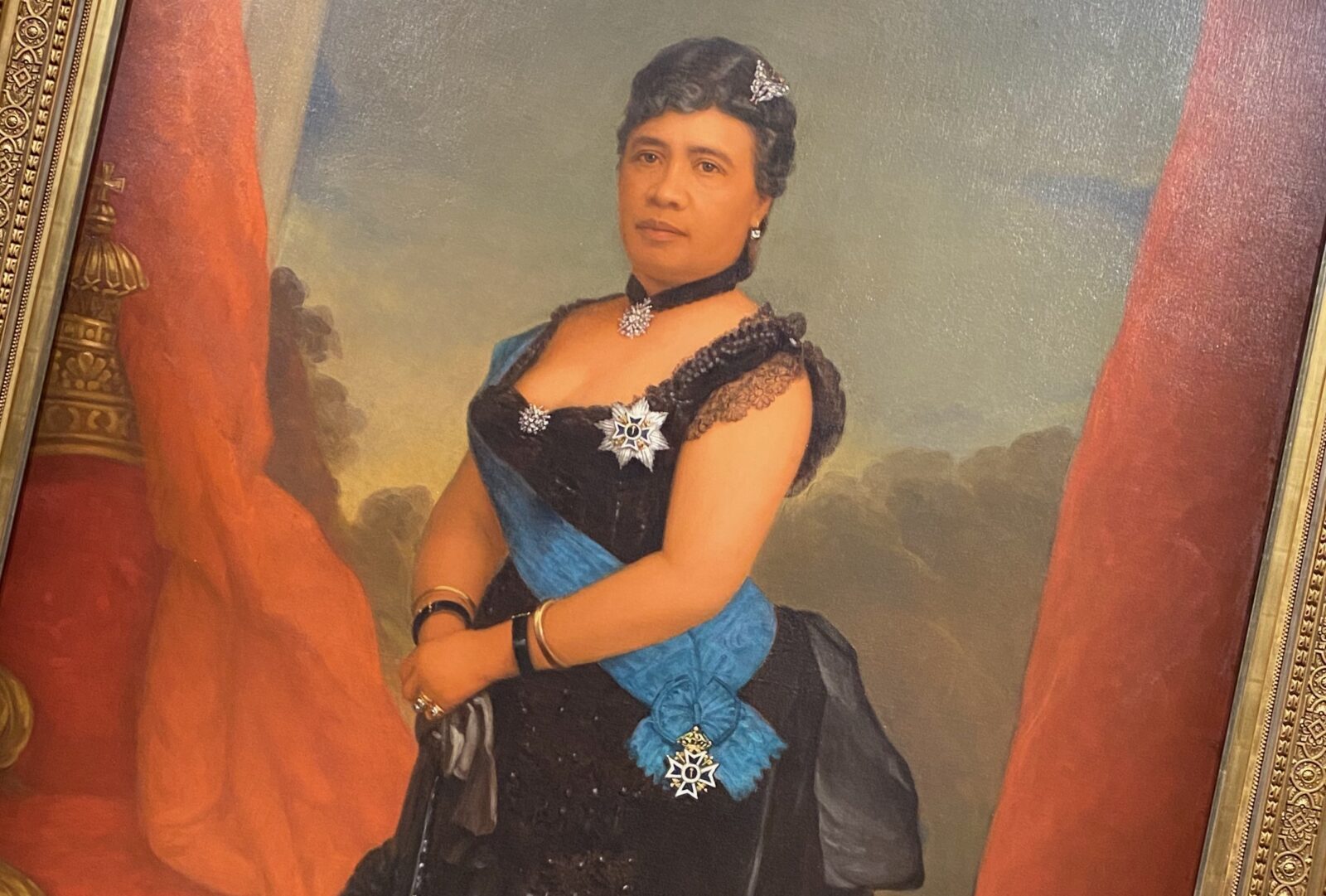May 30, 2023
Portrait of a Queen: Hawaiian History and the Law
Joanna Lau Sullivan Distinguished Professor, University of Hawai‘i at Mānoa William S. Richardson School of Law

This piece is part of a blog series highlighting key legal issues facing Asian American and Pacific Islander communities.
Last week, I walked into a special exhibit in the National Portrait Gallery in Washington, D.C., and was confronted with a large painting of Hawai‘i’s last sovereign, Queen Lili‘uokalani. In the portrait, the Queen peers out at visitors as they seek to beat the Potomac heat, as if to say, “listen to my story.” The portrait, which, for the first time, journeyed halfway across the globe from its home in Hawai‘i, was a poignant reminder of the same voyage that the Queen took more than a century ago to tell the history of her people and her stolen nation.
American Overthrow
For centuries, Hawai‘i’s indigenous people lived in a highly sophisticated and self-sustaining community. As with many other indigenous peoples, western contact brought about the near demise of Native Hawaiians. Despite dwindling numbers, the Native Hawaiians persevered and created an independent and internationally recognized Kingdom of Hawai‘i.
Yet, in 1893, and capitalizing on American expansionism across the Pacific Ocean, the marines of the U.S.S. Boston unlawfully landed on the shores of the Kingdom. The insurrectionists forced the then-Queen, Lili‘uokalani, to make a decision to either suppress the American-supported coup and face the wrath of the American military, or cede her authority and hope that the rule of law in Washington, D.C. would prevail. To avoid bloodshed, the Queen chose the peaceful and diplomatic path. The bloodless coup, however, resulted in the illegal overthrow of the Kingdom and calls for immediate annexation.
President Grover Cleveland condemned his countrymen’s conduct in the islands as an “act of war.” Kingdom citizens refused to sit idly and let the United States seize their land and their sovereignty. Community leaders gathered petitions expressing strong opposition to annexation. After being delivered to Congress, in 1897, these petitions helped make the case against Senate ratification of a proposed annexation treaty. Nevertheless, American imperialism prevailed. In 1898, and although the United States Senate never ratified a treaty of annexation as required under the Constitution, the McKinley Administration seized Hawai‘i through a joint resolution.
Throughout this period and even following annexation, Queen Lili‘uokalani spent significant time in Washington, D.C. She met with politicians of all parties to plead the case for her people. Although halfway across the world, she never gave up and she told Hawai‘i’s story.
The Project of Americanization
But, the injustices continued. Congress subsequently created the Territory of Hawaii in 1900 and, for decades, the project of Americanization inculcated the islands. Children (and their teachers) were punished for speaking the native language. Cultural practices were forced underground or, even worse, commodified to placate a growing tourism industry. Prime agricultural lands and precious natural resources were diverted from native farmers to support the sugar and pineapple industries.
The massive military presence in Hawai‘i made our lands and our people the target for anti-American sentiments just as America was poised to enter World War II. The Territory’s criminal justice system disproportionately and unfairly punished brown bodies. Native Hawaiians had the lowest rates of educational attainment, and the highest rates of incarceration and death. The project of Americanization was nearly complete.
Promise of Reconciliation
Then, in 1978, something changed. Following a state constitutional convention, the multi-ethnic voters in Hawai‘i approved generation-shifting laws regarding traditional practices, the Hawaiian language, and reconciliation with Native Hawaiians. One of these constitutional amendments—the creation of the Office of Hawaiian Affairs—sought to alter the relationship between the State of Hawai‘i and the indigenous Hawaiian people. This new agency would be run by and for the betterment of the conditions of Native Hawaiians. It would serve as a vehicle for reparative action for the historical harms of colonization.
President Bill Clinton and a bipartisan Congress amplified this message of hope for redress for historical harms when, in 1993, they apologized for the overthrow and committed to support reconciliation efforts between the United States and Native Hawaiians. While not perfect, the movement for reconciliation for the harms of the seizure of Hawaiian lands and sovereignty took significant steps forward.
Reconciliation at a Crossroads
In 2000, the United States Supreme Court struck a blow to this reparatory momentum with its startling decision in Rice v. Cayetano, 528 U.S. 495 (2000). In that case, a white Hawai‘i resident challenged the Native Hawaiian-only voting limitations for the leaders of the Office of Hawaiian Affairs. The Court ignored the efforts of the state and federal governments to address the historical harms of colonization and the unique effort to provide a semblance of self-governance to Native Hawaiians through the Office of Hawaiian Affairs. The Court majority whitewashed the history of Hawai‘i and its native people. The Court then used that biased history to frame their legal conclusion and equate ancestry with race. In short, the Court denied Native Hawaiians their self-governance.
Since Rice, the path to justice for Native Hawaiians has been fraught with controversy. Any federal lawsuit dealing with Native Hawaiian issues has been forced to reconcile with the improperly premised and wrongly decided Rice decision. Even other indigenous communities across the Pacific, such as in Guam and the Northern Mariana Islands, have been shackled by Rice.
While the road to overturning Rice and correcting Hawai‘i’s history in the law seems to be perilous, to see Queen Lili‘uokalani revisit Washington, D.C.—even if just in a portrait—provides hope that Hawai‘i’s true history continues to be told. During this time as America celebrates Asian American, Native Hawaiian, and Pacific Islander Heritage Month, learn more about our unique histories and beautiful stories, and continue to share them. The fight for justice begins with sharing our stories.
____________________
 Troy J.H. Andrade is the Joanna Lau Sullivan Distinguished Professor and director of the Ulu Lehua Scholars Program at the University of Hawai‘i at Mānoa William S. Richardson School of Law. His scholarship lies at the intersection of American jurisprudence and legal history, particularly in the context of the pursuit of Native Hawaiian political and social justice.
Troy J.H. Andrade is the Joanna Lau Sullivan Distinguished Professor and director of the Ulu Lehua Scholars Program at the University of Hawai‘i at Mānoa William S. Richardson School of Law. His scholarship lies at the intersection of American jurisprudence and legal history, particularly in the context of the pursuit of Native Hawaiian political and social justice.




